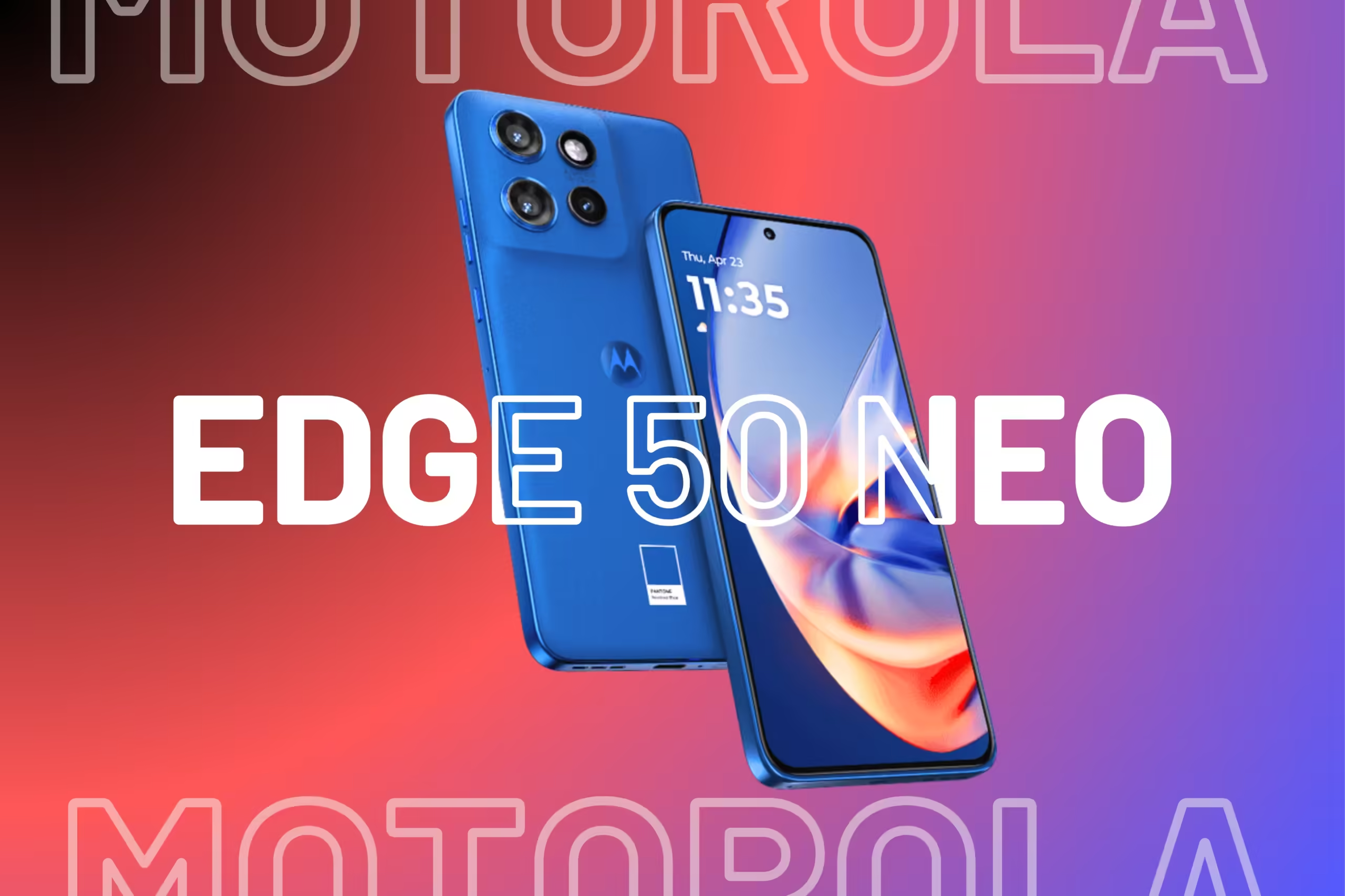
From the budget-friendly Motorola Edge 50 Fusion to the high-end Motorola Edge 50 Pro, Motorola has been busy in recent months. Now, they’ve introduced the Motorola Edge 50 Neo, priced just Rs 1,000 more than the Edge 50 Fusion.
With the smartphone market under Rs 25,000 being highly competitive, where does Motorola’s newest model fit in? I’ve spent some time with the Motorola Edge 50 Neo, and here are my initial impressions!
Motorola Edge 50 Neo Specifications

What’s in the Box
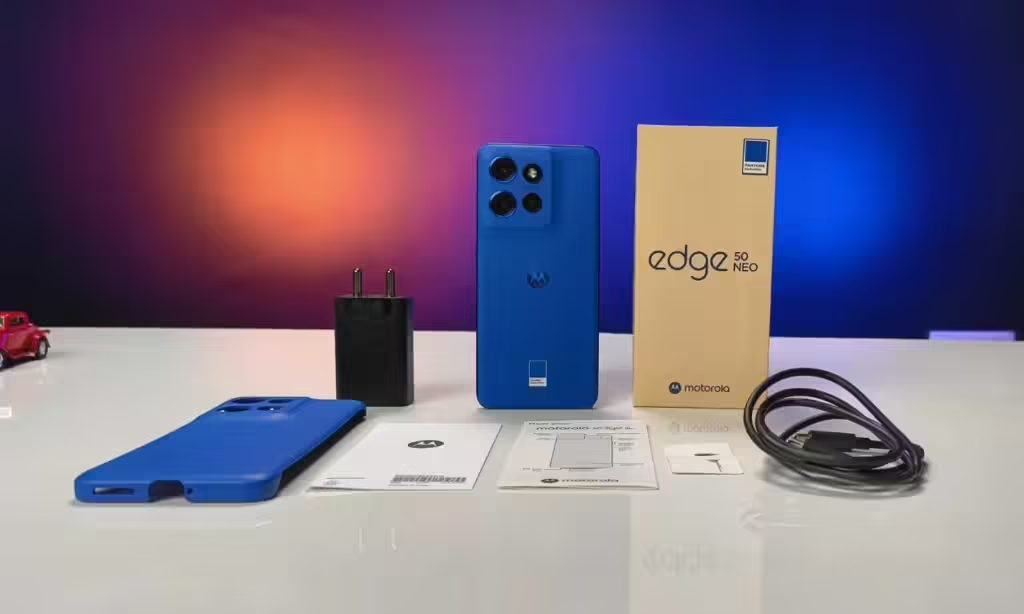
As usual, Motorola provides a comprehensive selection of accessories in the box. Here’s what you’ll find:
- Color-matched case
- 68W Turbo Charger
- Type-C to Type-C cable
- SIM Ejector Tool
- Paperwork
And, of course, there’s the signature Motorola touch to complete the package. But is the device worth all this excitement? Keep reading to find out!
Design and Build

I have the Nautical Blue color variant of the smartphone, though it’s not my favorite. I’d opt for the Poinciana (orange) variant instead. The phone is also available in Latte (cream) and Grisaille (greyish).
One notable change is the shift to a flat display, which I appreciate. As someone who has already cracked the display on my OnePlus 11R due to the lack of tempered glass (I prefer not to use UV protection), I respect Motorola’s decision. The flat design does make the phone feel less curved compared to other Motorola models, but that’s not a major issue.
The size has been reduced from the Edge 40 Neo’s dimensions of 159.63 x 71.99mm to 154.1 x 71.2mm. However, the Edge 50 Neo is slightly thicker at 8.1mm compared to its predecessor’s 7.89mm.

The device feels similar in-hand to the Samsung Galaxy S23 FE, but with a less boxy design. It settles comfortably into your palms without feeling prickly and is incredibly lightweight, making it a joy to carry. The in-hand experience of this smartphone is truly impressive!
Motorola continues its trend of using vegan leather for the rear panel, which adds a premium touch amidst a sea of plastic phones. Despite the plastic frame, the excellent form factor makes it feel solid and well-built. The plastic buttons are notably tactile.
Additionally, the phone boasts an IP68 rating and MIL-810H (Military Grade) certification, making it a durable choice overall.
Display and Speakers

At 6.4 inches, the display isn’t as compact as I would have preferred, but surprisingly, it is still the most compact option in its segment. The 1.5K resolution pOLED panel with a 120Hz refresh rate and LTPO technology is a significant plus. LTPO allows for seamless switching between high and low refresh rates without additional hardware, enhancing power efficiency and extending battery life. The bezels are narrow overall, with the top and chin being slightly wider.
This is the first Motorola Edge series device to feature LTPO. It also includes Smart Water Touch 2.0, which ensures usability even with sweaty hands or rain droplets, making it quite practical in various weather conditions. Additionally, the display supports Always On functionality.

The display is impressively sharp, vibrant, and exceptionally bright. Our LuxMeter measured it reaching 3,500 nits in HDR content, surpassing the brand’s claimed 3,000 nits. In High Brightness Mode (HBM), it achieves around 900 nits of its claimed 1,400 nits, which is still impressive. HDR content looks outstanding, with deep blacks and well-balanced color tones, making scenes like the dragon chase in Damsel on Netflix visually stunning.
The multimedia experience is further enhanced by dual stereo speakers with Dolby Atmos support. The sound separation is approximately 40:60, and the surround effect from Dolby Atmos is quite effective. The speakers provide noticeable bass, with punchy mids and clear highs.
Additionally, the display is protected by Gorilla Glass 3, making it quite resistant to scratches, though it’s still best to avoid dropping it.
Performance

Motorola’s latest Edge 50 Neo packs a decent punch with the MediaTek Dimensity 7300 chipset, the same processor (7300X variant for foldables) found in the much pricier Motorola Razr 50 (first impressions). While it doesn’t match the power of the OnePlus Nord CE 4’s (review) Snapdragon 7 Gen 3 in the same segment, it holds its own.
The processor is paired with up to 8GB of LPDDR4X RAM and 256GB of UFS 2.2 storage, which is a bit underwhelming. Motorola’s continued use of UFS 2.2, even in the Razr 50, feels outdated. It’s time the brand shifts to UFS 3.1 or adopts the smarter UFS 2.2c approach like the Nothing Phone 2a (review). That said, RAM management is decent, as most of the 10 apps I had running in the background resumed without issues.
When it comes to benchmarks, the results aren’t exceptional, but here’s a quick look at the numbers:
Despite its compact size, the Motorola Edge 50 Neo stays impressively cool. Even after over an hour of gaming, the phone barely surpassed 35 degrees (in an air-conditioned environment), which is remarkable. Additionally, gaming on a device this size is a joy, as it fits comfortably in your hands. With that in mind, here’s a rundown of the graphics and settings you can expect while gaming on this phone:

Cameras
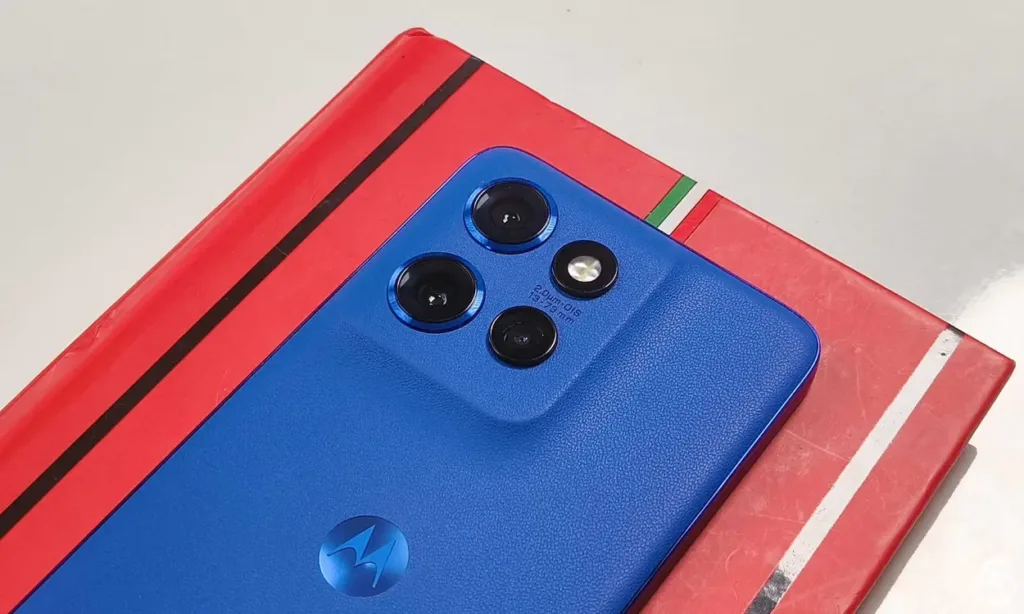
While I didn’t have the chance to do an in-depth photo walk with the Motorola Edge 50 Neo like I did with the Nikon Zf (review), my brief experience gave me a solid impression. The 50MP Sony Lytia 700C primary sensor and the 13MP ultra-wide lens perform well, but the standout is the 10MP telephoto sensor.
This might be the most affordable phone to offer 3x optical zoom, outshining competitors like the Realme 12 Pro, which maxes out at 2x optical zoom. In terms of camera performance, daytime shots are impressive, with a good dynamic range.
Unlike the color saturation seen in the Edge 50 Fusion and Edge 50 Pro, the colors here are more natural. The shots capture good detail, with exposure being handled very well.
The ultra-wide camera on the Motorola Edge 50 Neo is impressive, offering much better detail compared to the 8MP ultra-wide sensors typically found in this segment. Most notably, the telephoto lens performs excellently, without any awkward color disparity. Zoomed-in details exceeded my expectations as well.



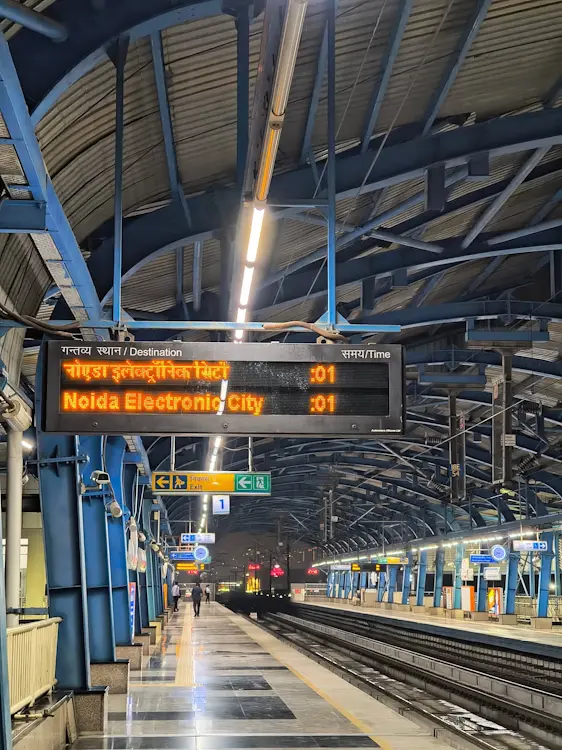
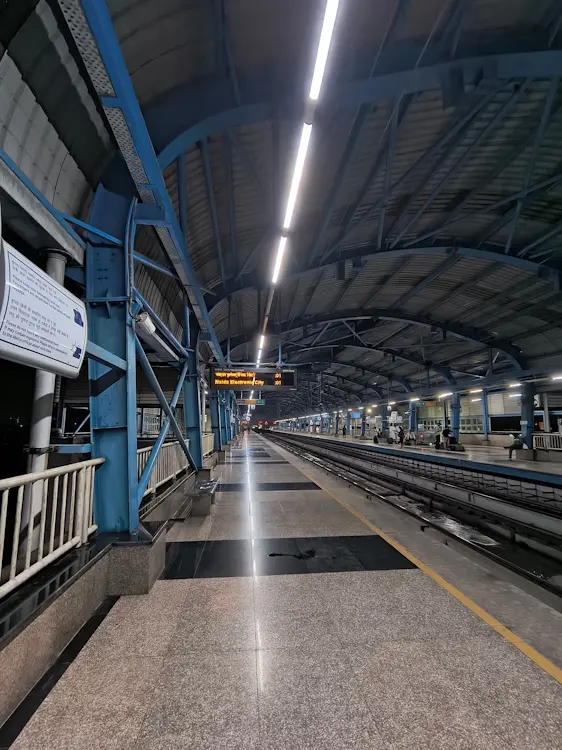
Night photography is solid, with the phone managing light sources effectively and balancing shadows and highlights nicely. However, the color tones at night aren’t as natural as they are during the day, with some noticeable boosting in play.
Portrait shots on the Motorola Edge 50 Neo are impressive, with excellent skin texture and hair detailing. The edge detection and depth mapping are handled well without being overdone. However, the skin tones tend to be slightly boosted and not entirely true to life. Selfies exhibit similar processing, though the details remain solid.
When it comes to videos, the Edge 50 Neo supports up to 4K at 30FPS. Footage from the primary sensor is stable, thanks to OIS. However, switching between sensors during video recording is limited to 1080p at 30FPS, with no option to shuffle between them at 4K.
Software Experience

Over the past few months, I’ve really come to appreciate Motorola’s revamped Hello UI. The smooth animations and greatly improved haptic feedback compared to the original MyUX skin make for a much better experience overall.
However, I’ve observed that Hello UI isn’t entirely consistent and its performance can vary from one device to another.
On the Edge 50 Neo, Hello UI runs exceptionally smoothly with no bugs or glitches so far. It’s arguably the cleanest Android skin in its segment, right after Nothing OS. However, it offers a lot more features, and Smart Connect (formerly Ready For) has truly won me over.
Our talented senior tech writer, Md Mati Uddin, recently discovered that Motorola’s Smart Connect works with any Android phone, which is really impressive. Additionally, the Motorola Edge 50 Neo includes useful apps like Moto Unplugged, and while it comes with pre-installed Facebook and LinkedIn, that’s about the extent of the bloatware, which you can easily uninstall.
Most importantly, the Motorola Edge 50 Neo is supported by 5 years of major OS updates and security patches. With Android 14-based Hello UI right out of the box, it’s expected to receive updates up to Android 19. I just hope Motorola stays on top of the updates and delivers them on schedule (fingers crossed).
Battery Life and Charging

The Motorola Edge 50 Neo doesn’t have the largest battery, with its 4,310mAh capacity. Despite the 1.5K resolution and Always On display, I only achieved around 5 hours of screen-on time with casual use, which falls short of my expectations for LTPO technology. It seems like some battery optimization could be beneficial.
My casual usage includes a fair amount of doom scrolling on Instagram and Facebook, staying active on X, Reddit, and Feedly, and playing some CoD Mobile. With lighter usage, you might get around 6 hours of screen time. I also noticed a 4% battery drain overnight while the phone was idle.
Regarding charging, although I didn’t measure it in detail, it took about 40 minutes to fully charge the phone from 24%. Overall, the charging speed is decent.
Is the Motorola Edge 50 Neo a Good Investment?

Although I’ve reviewed several budget phones like the Nothing Phone 2a and OnePlus Nord CE 4, I haven’t considered using them as my primary device. However, the Motorola Edge 50 Neo is so impressive that I’m eager to make it my daily driver.
I’m pleased to see that Motorola didn’t skimp on features, aside from the plastic construction and slightly underwhelming processor. The inclusion of IP68 water and dust resistance and a Military-Grade build is quite rare in this segment.
The Motorola Edge 50 Neo features a bright, near-compact 6.4-inch 1.5K 120Hz pOLED display and a solid speaker setup. Coupled with its impressive camera system and powerful telephoto sensor, it stands out significantly. If the battery optimization were more refined, this phone would be even more remarkable.
The promise of 5 years of software updates is particularly impressive, especially if Motorola delivers on it. No other phone in this segment offers more than 3 years of updates, with the closest competitor being the OnePlus Nord 4, which provides a 4+6 policy but is priced higher than the Motorola Edge 50 Neo’s Rs 23,999 (excluding bank offers).
Considering everything, the Motorola Edge 50 Neo stands out as the best value-for-money smartphone in its segment this year. Well done, Motorola!
